HomeReviewsSolium Infernum
Solium Infernum review: a fiendish strategy game best played with friendsDevil takes the hindmost
Devil takes the hindmost
Image credit:Rock Paper Shotgun/League Of Geeks
Image credit:Rock Paper Shotgun/League Of Geeks
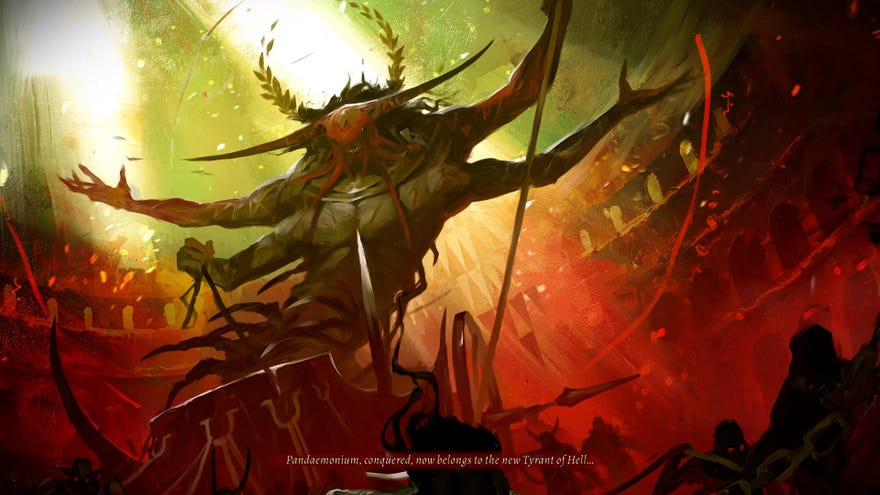
Landmarks, such as the appropriately named volcano Dante’s Peak complicate how you get around the map, but collect the right manuscripts and you can pass over lava, ravines, swamps to aid your movement. |Image credit:Rock Paper Shotgun/League Of Geeks
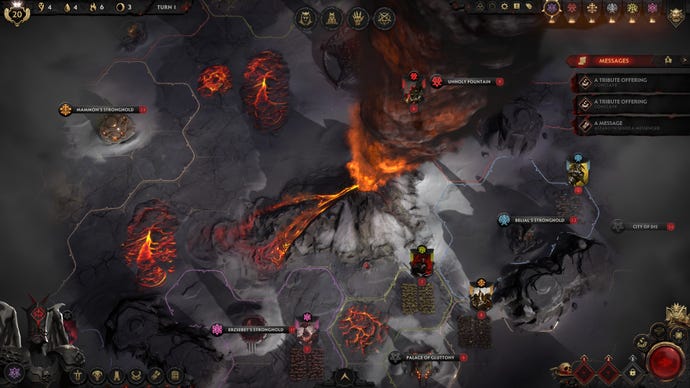
Before I get into the nitty gritty of how Solium Infernum works, let’s take a beat to look at what you’re actually getting. For solo players, there’s a lengthy tutorial that lets you play a full game to completion, as well as a single match skirmish mode where you can play against the AI. Rounding it out are the Chronicles, a series of eight special scenarios where you play as specific Archfiends whose objectives to seize the throne become increasingly elaborate and challenging as you work up from the entry-level Moderate missions to the (definitely not kidding around) Hellish ones. Each of these will take you a good couple of hours to complete successfully, and with secondary objectives also factoring in to their respective bronze, silver and gold rankings, there’s a sizable amount to sink your teeth into here before you exhaust everything.
To see this content please enable targeting cookies.Manage cookie settings
To see this content please enable targeting cookies.Manage cookie settings
In playing games with fellow reviewers over the last couple of weeks, I’ve certainly been guilty of a few memory lapses now and again, but thankfully League Of Geeks have made brilliant and vital use of Steam’s built-in notification system here to prompt you when new turns are available. It works on both desktop and Steam’s mobile app, too, but I’d say the latter is a much more effective reminder than the silent, disappearing pop-up window on desktop. For me, the mobile app was an essential tool in making me log in, have a ponder, submit my turn, and then log back out again, so I’d strongly recommend installing Steam on your phone if you plan to play this for the long haul.
|Image credit:Rock Paper Shotgun/League Of Geeks
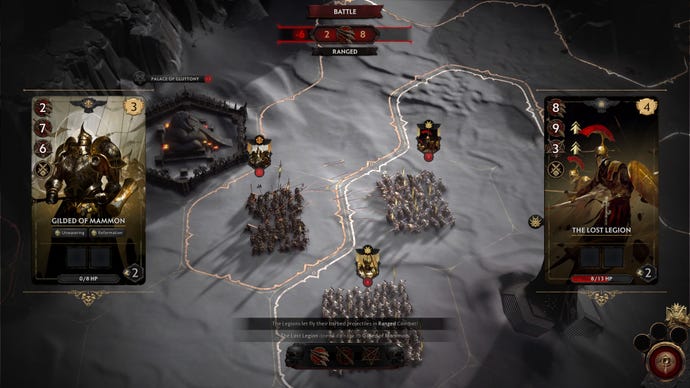
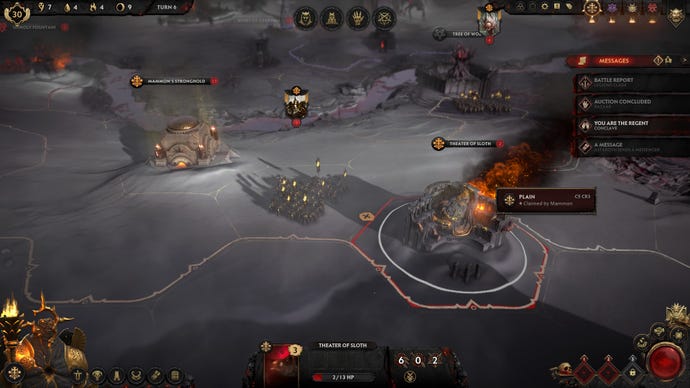
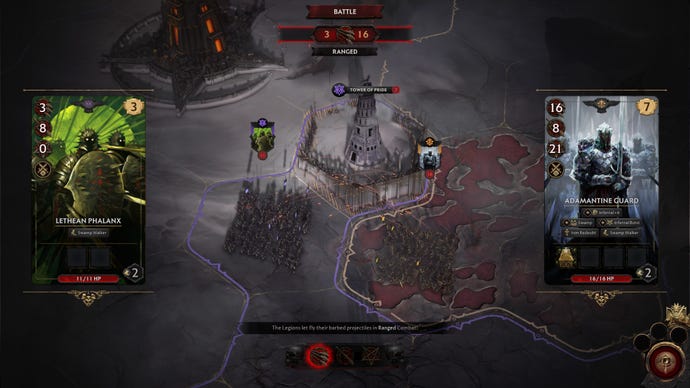
But enough dilly-dallying. Let’s get to the business of how one rules over hell and, most importantly, rubs it in the faces of all the other Archfiends in the process. Solium is, at its heart, a game of social deduction, and is perhaps best thought ofin the same breadthas your Werewolves, Secret Hitlers, andBattlestar Galacticaboard games. It’s a very cerebral and calculating type of tactical experience, and one where the territory-expanding powerplays you act out on the (conveniently) hexagonal fields of hell are just as important as the ones you conduct behind the scenes.
The latter can encompass casting spells and hexes on your opponents to either cripple them ahead of battle or take a peek into their coffers to see what they’re planning, or maybe even sending notes to strike up secret, if somewhat temporary alliances between players. Or perhaps you’d prefer to amass your own collection of stat-boosting artifacts, ability-bestowing manuscripts or army-boosting praetor champions to build up your defences and strengthen your legion foot soldiers. You’ll need coin (or tribute, in the game’s parlance) to fund these ventures, but getting more of it will require you to give up one of your initially very limited action points, so deciding how and when to bolster your coffers at the expense of other actions is all part of what makes Solium such a meaty and fiendish game to try and untangle. Alternatively, you can invest that tribute currency into your own five core power stats, earning yourself not just more action points in the process, but also increasing your resistance to the plots and ritual spells of your enemies.
Diplomacy, of a sort, is a viable option as well, though in hell the demands are always high, and refusals come with devastating consequences. Insults can lead to territory invasions or a duel between praetors, and if you end up suffering the indignity ofacceptingorgiving into these demands, you’ll lose some of your all-important Prestige in the process.
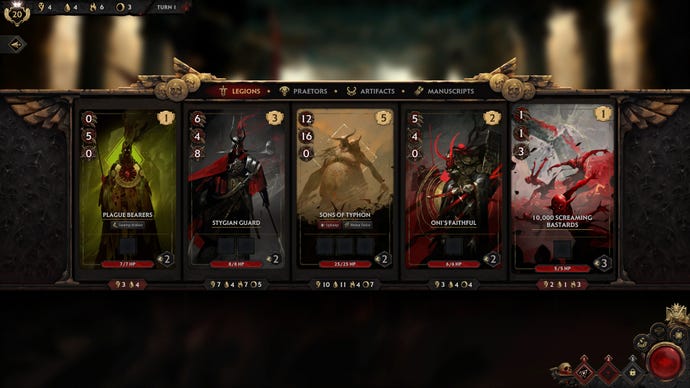
As you might have surmised, there are many paths to the throne of hell, and with turns all resolving simultaneously, watching everyone clamber hand over foot as they react to the ensuing carnage play out is precisely what gives Solium Infernum such strategic bite. Plans will be thwarted, schemes will be scuppered, and emotions will always run high - which is quite the feat considering this is ultimately quite a grey and quiet sort of game in the moment to moment, its moody organs and cherubic vocal blasts often only reserved for key events and proclamations. That it can provoke such vivid and primal reactions in you is a testament to its depth and cunning.
At the same time, though, there are still some significant hurdles in the way before you can truly start enjoying Solium Infernum. While the tutorial does a good job of explaining the basic concepts of the game, the business of getting to grips with each of the eight Archfiends' strengths and weakness still remains a daunting and difficult task. Yes, having eight defined characters is an infinitely better solution to the near-infinite possibilities you had in the original Solium, but they are still difficult to unpick without proper tutelage.
Ah, the diplomacy screen - and as is perhaps appropriate for a game of Solium Infernum, this particular match almost made a pentagram of vendettas and blood feuds. |Image credit:Rock Paper Shotgun/League Of Geeks

Each Archfiend also has their own Sanctum (left) where they can plot additional objectives for themselves or play event cards, but you also get to see other Archfiends in their natural habitat (right) when they make demands (or in this case, proposals of vassalage), too. |Image credit:Rock Paper Shotgun/League Of Geeks
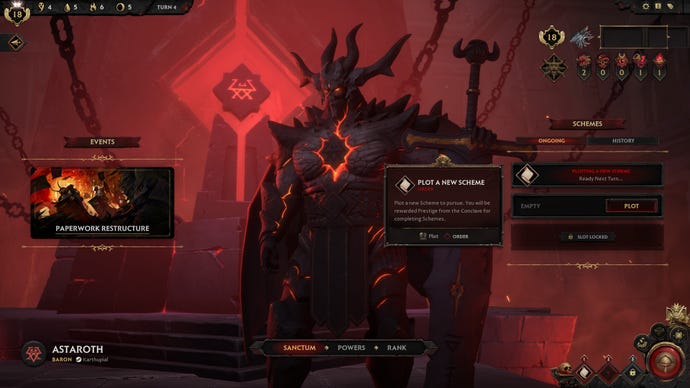
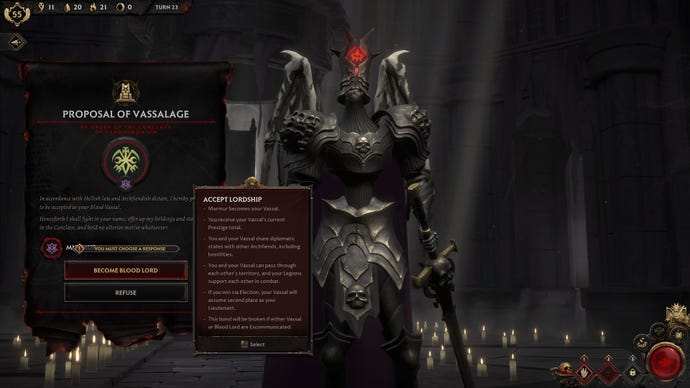
The Chronicles certainly help on this front, as each scenario feels uniquely tailored to really getting the most out of their particular play styles. But at the same time, trying to learn the ins and outs of Queen of Flies Beelzebub, or how smug pants Andromalius is best utilised on Hellish difficulty (and only Hellish difficulty) is perhaps a leap too far for your average player (I mean me, I’m your average Solium player). Indeed, your only other option is to simply muck about in a “short” 30-turn skirmish against the AI, but even this is still quite the commitment, especially if you’re feeling around in the dark while also trying to juggle and react to multiple stratagems across what can be quite slow-moving turns to begin with. It can easily slide into slog territory, which could have been avoided if the Chronicles had a wider variety of difficulty settings.
Similarly, while the Chronicles do a good job of highlighting all the different ways one can gain Prestige to earn a victory, the simplest and easiest way to do this is to capture as many Places Of Power on the map as possible. These are the only real reason you’ll want to expand and hold your territory in Solium Infernum (besides paving an easy path to Pandemonium, of course), as there’s basically nothing else to really focus on. There are no mines or resources to pilfer, for example, or any other points of interest to draw the attention of your opponents. As such, most battles and vendettas will be fought trying to claim Places Of Power for your own, and having played lots of games in reasonably quick succession, matches all start to fall into the same old patterns as a result.
Big beasty boys can be summoned onto the battlefield if you play your rituals right, but playing for their upkeep across multiple turns make them a costly strategy. |Image credit:Rock Paper Shotgun/League Of Geeks

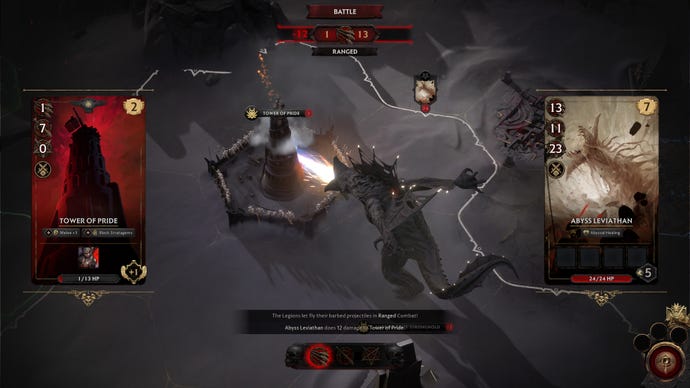
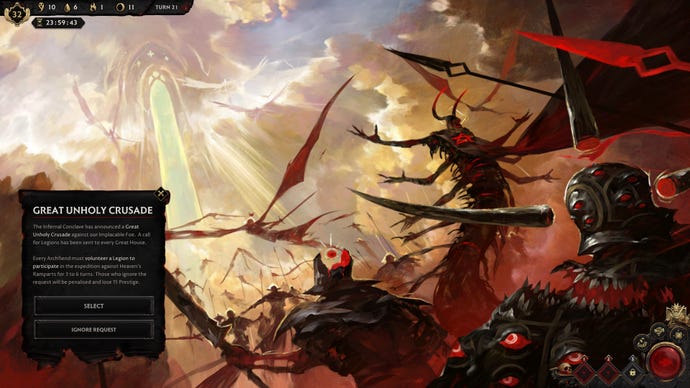
This alone may be reason enough to encourage players to experiment with alternative routes to victory. But having attempted some of them via the Chronicles scenarios, I’ve yet to be convinced that they’re really worth the effort. Admittedly, the emphasis is very much on ‘attempt’ here, as I’ve come to realise that I either don’t have the mega brain to pull them off successfully, or they are, in fact, just a bit too fussy and long-winded to pull off properly. Indeed, for all the very welcome efforts League Of Geeks have made to make this version of Solium as approachable as possible, this is still a very hard and challenging game at the end of the day, and it will take you multiple matches to really feel like you know what you’re doing (and even then, there are still parts of this game that feel under-tutorialised - praetor duels, I’m looking at you).